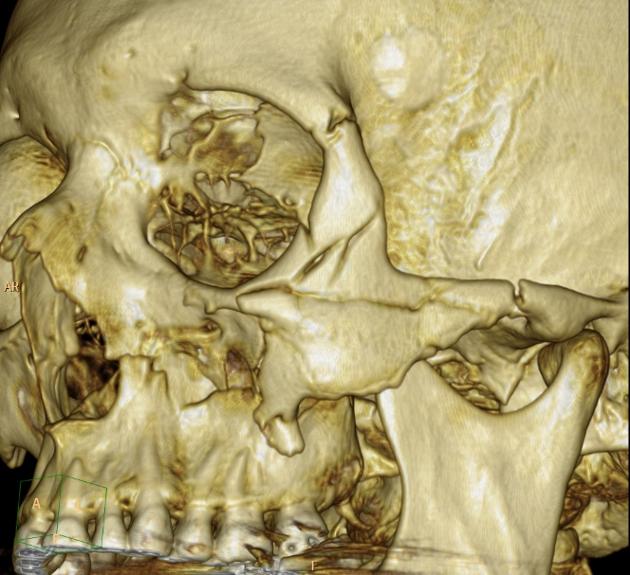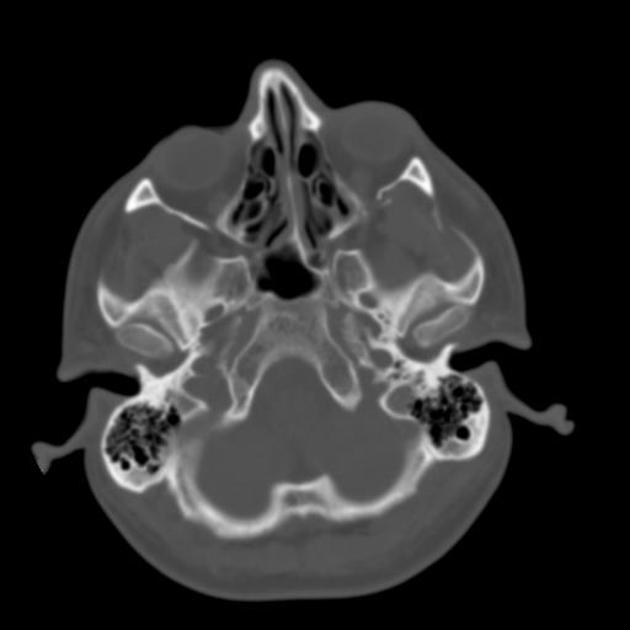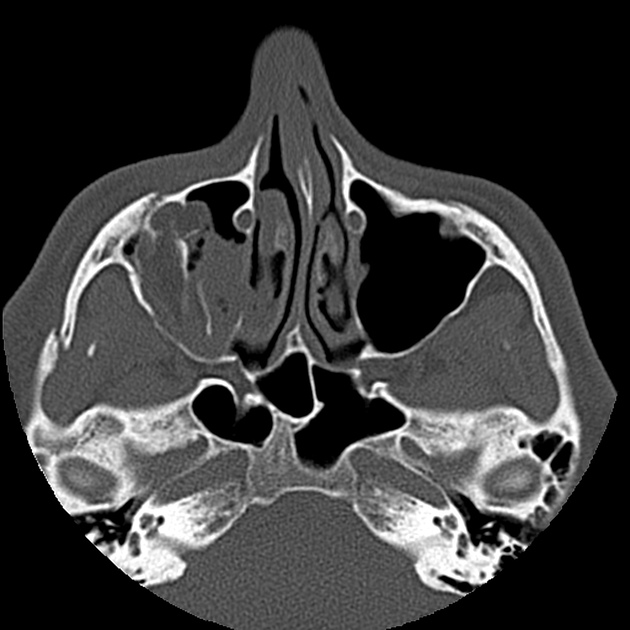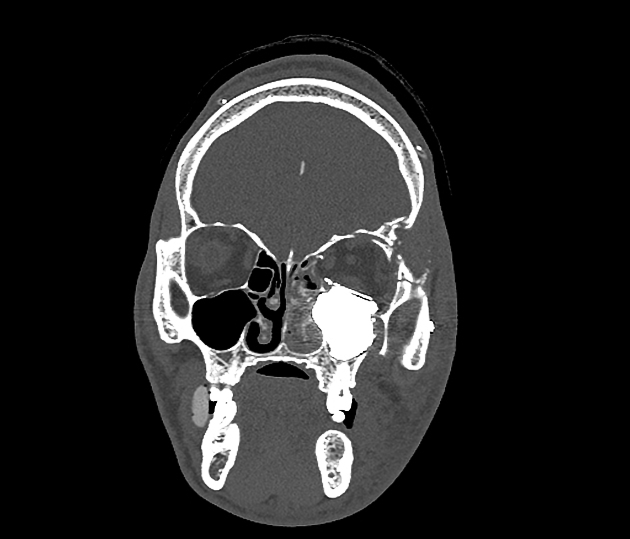Zygomaticomaxillary complex fracture
Citation, DOI, disclosures and article data
At the time the article was created Nasir Siddiqui had no recorded disclosures.
View Nasir Siddiqui's current disclosuresAt the time the article was last revised Ashesh Ishwarlal Ranchod had no financial relationships to ineligible companies to disclose.
View Ashesh Ishwarlal Ranchod's current disclosures- Tripod fracture
- Malar fracture
- Trimalar fracture
- Zygomaticomaxillary complex fractures
- Zygomatico-maxillary complex fracture
- Tripod fractures
- Malar fractures
- Trimalar fractures
- ZMC fracture
Zygomaticomaxillary complex (ZMC) fractures, also known as tripod, tetrapod, quadripod, malar or trimalar fractures, are seen in the setting of traumatic injury to the face. They comprise fractures of the:
inferior orbital rim, and anterior and posterior maxillary sinus walls
lateral orbital rim
On this page:
Epidemiology
They can account for ~40% of midface fractures. They are the second most common facial bone fracture after nasal bone fractures.
Pathology
The fracture complex results from a direct blow to the malar eminence and results in three distinct fracture components that disrupt the anchoring of the zygoma. Additionally, the fracture components may result in impingement of the temporalis muscle, trismus (limited jaw mobility) and may compromise the infraorbital foramen/nerve resulting in hypoesthesia (numbness) within its sensory distribution.
Radiographic features
On radiographic evaluation, typically with dedicated CT imaging with multiplanar reformats, the following three fracture components are generally identified:
fracture of the zygomatic arch and/or diastasis of the temporozygomatic suture
fractures of the inferior orbital rim and anterior and posterior maxillary sinus walls and/or diastasis of the zygomaticomaxillary suture
fracture of the lateral orbital rim and/or diastasis of the frontozygomatic suture
Treatment and prognosis
If needed, closed or open reduction methods can be performed with the goal of treatment being preservation of normal facial structure, sensory function, globe position and mastication functionality.
Quiz questions
References
- 1. Laine FJ, Conway WF, Laskin DM. Radiology of maxillofacial trauma. Curr Probl Diagn Radiol. 1993;22 (4): 145-88. Pubmed citation
- 2. Zingg M, Laedrach K, Chen J et-al. Classification and treatment of zygomatic fractures: a review of 1,025 cases. J. Oral Maxillofac. Surg. 1992;50 (8): 778-90. Pubmed citation
- 3. Som PM, Curtin HD. Head and Neck Imaging - 2 Volume Set. Mosby. ISBN:0323053556. Read it at Google Books - Find it at Amazon
- 4. Danny Meslemani, Robert M. Kellman. Zygomaticomaxillary Complex Fractures. (2012) Archives of Facial Plastic Surgery. 14 (1): 62. doi:10.1001/archfacial.2011.1415
Incoming Links
- Tripod face fracture
- Zygomaticomaxillary complex fracture and chewable intraoral foreign body
- Tripod fracture
- Complex facial fracture
- Tripod and Le Fort 1 fractures
- Zygomaticomaxillary complex fracture
- Zygomatic arch fracture
- Tripod fracture
- Multiple facial fractures
- Multiple facial bone fractures
- Zygomaticomaxillary complex fracture and inferior orbital blowout
- Zygomaticomaxillary complex fracture
- Zygomaticomaxillary complex fracture
- Zygomaticomaxillary complex fracture
Related articles: Fractures
-
fracture
- terminology[+][+]
- fracture location
- diaphyseal fracture
- metaphyseal fracture
- physeal fracture
- epiphyseal fracture
- fracture types
- avulsion fracture
- articular surface injuries
- complete fracture
- incomplete fracture
- infraction
- compound fracture
- pathological fracture
- stress fracture
- fracture displacement
- fracture location
- fracture healing[+][+]
- skull fractures[+][+]
-
facial fractures
- fractures involving a single facial buttress[+][+]
- alveolar process fractures
- frontal sinus fracture
- isolated zygomatic arch fractures
- mandibular fracture
- nasal bone fracture
- orbital blow-out fracture
- paranasal sinus fractures
- complex fractures
- complex midfacial fracture
- Le Fort fractures
- naso-orbitoethmoid (NOE) complex fracture
- zygomaticomaxillary complex fracture
- dental fractures
- fractures involving a single facial buttress[+][+]
-
spinal fractures[+][+]
- classification (AO Spine classification systems)
-
cervical spine fracture classification systems
- AO classification of upper cervical injuries
- AO classification of subaxial injuries
- Anderson and D'Alonzo classification (odontoid fracture)
- Roy-Camille classification (odontoid process fracture)
- Gehweiler classifcation (atlas fractures)
- Levine and Edwards classification (hangman fracture)
- Allen and Ferguson classification (subaxial spine injuries)
- subaxial cervical spine injury classification (SLIC)
- thoracolumbar spinal fracture classification systems
- three column concept of spinal fractures (Denis classification)
- classification of sacral fractures
-
cervical spine fracture classification systems
- spinal fractures by region
- spinal fracture types
- classification (AO Spine classification systems)
- rib fractures[+][+]
- sternal fractures
-
upper limb fractures[+][+]
- classification
- Rockwood classification (acromioclavicular joint injury)
- AO classification (clavicle fracture)
- Neer classification (clavicle fracture)
- Neer classification (proximal humeral fracture)
- AO classification (proximal humeral fracture)
- AO/OTA classification of distal humeral fractures
- Milch classification (lateral humeral condyle fracture)
- Weiss classification (lateral humeral condyle fracture)
- Bado classification of Monteggia fracture-dislocations (radius-ulna)
- Mason classification (radial head fracture)
- Frykman classification (distal radial fracture)
- Mayo classification (scaphoid fracture)
- Hintermann classification (gamekeeper's thumb)
- Eaton classification (volar plate avulsion injury)
- Keifhaber-Stern classification (volar plate avulsion injury)
- upper limb fractures by region
- shoulder
- clavicular fracture
-
scapular fracture
- acromion fracture
- coracoid process fracture
- glenoid fracture
- humeral head fracture
- proximal humeral fracture
- humeral neck fracture
- arm
- elbow
- forearm
- wrist
-
carpal bones
- scaphoid fracture
- lunate fracture
- capitate fracture
- triquetral fracture
- pisiform fracture
- hamate fracture
- trapezoid fracture
- trapezium fracture
- hand
- shoulder
- classification
- lower limb fractures[+][+]
- classification by region
- pelvic fractures
- hip fractures
- Pipkin classification (femoral head fracture)
- Garden classification (hip fracture)
- American Academy of Orthopedic Surgeons classification (periprosthetic hip fracture)
- Cooke and Newman classification (periprosthetic hip fracture)
- Johansson classification (periprosthetic hip fracture)
- Vancouver classification (periprosthetic hip fracture)
- femoral
- knee
- Schatzker classification (tibial plateau fracture)
- AO classification of distal femur fractures
- Meyers and McKeevers classification (anterior cruciate ligament avulsion fracture)
- tibia/fibula
- Watson-Jones classification (tibial tuberosity avulsion fracture)
- ankle
- foot
- Berndt and Harty classification (osteochondral lesions of the talus)
- Sanders CT classification (calcaneal fracture)
- Hawkins classification (talar neck fracture)
- Myerson classification (Lisfranc injury)
- Nunley-Vertullo classification (Lisfranc injury)
- pelvis and lower limb fractures by region
- pelvic fracture
- sacral fracture
- coccygeal fracture
-
hip
- acetabular fracture
- femoral head fracture
-
femoral neck fracture
- subcapital fracture
- transcervical fracture
- basicervical fracture
-
trochanteric fracture
- pertrochanteric fracture
- intertrochanteric fracture
- subtrochanteric fracture
- femur
- mid-shaft fracture
- bisphosphonate-related fracture
- distal femoral fracture
- knee
- avulsion fractures
- Segond fracture
- reverse Segond fracture
- anterior cruciate ligament avulsion fracture
- posterior cruciate ligament avulsion fracture
- arcuate complex avulsion fracture (arcuate sign)
- biceps femoris avulsion fracture
- iliotibial band avulsion fracture
- semimembranosus tendon avulsion fracture
- Stieda fracture (MCL avulsion fracture)
- patellar fracture
- tibial plateau fracture
- avulsion fractures
- leg
- tibial tuberosity avulsion fracture
- tibial shaft fracture
- fibular shaft fracture
- Maisonneuve fracture
- ankle
- foot
- tarsal bones
- metatarsal bones
- phalanges
- classification by region
- terminology[+][+]












 Unable to process the form. Check for errors and try again.
Unable to process the form. Check for errors and try again.